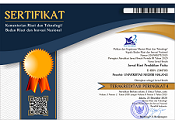Kemampuan Berpikir Kritis Siswa pada Pembelajaran Structured Inquiry Berbantuan Socratic Questioning: Materi Optika Geometri
Abstract
Keywords
Full Text:
PDFReferences
Kemendikbud, Konsep dan Implementasi Kurikulum 2013. Jakarta: Kementerian Pendidikan dan Kebudayaan, 2014.
K. H. Koh, Charlene, and P. Tee, “Creating Thinking Schools through Authentic Assessment: The Case in Singapore,” Educ. Assessment, Eval. Account., vol. 24, no. 2, pp. 135–149, 2012.
Sutopo, “Miskonsepsi pada Optika Geometri dan Remidiasinya,” J-TEQIP, vol. 5, no. 2, pp. 356–368, 2014.
M. John, J. M. Molepo, and M. Chirwa, “How Do Learners Conceptualize Plane Mirror Reflection? A Case Study of Grade 11 South African Learners,” Int. J. Educ. Sci., vol. 13, no. 2, pp. 221–230, 2016.
Sutrisno and F. Hadi, “How Does The Students’ Critical Thinking Ability in Geometry Optics?,” Unnes Sci. Educ. J., vol. 7, no. 2, 2018.
E. Pratiwi, A. Suyatna, and E. Suyanto, “Pengembangan Multimedia Interaktif (MMI) Tutorial dalam Pembelajaran Materi Optik Geometri,” J. Pembelajaran Fis., vol. 1, no. 6, pp. 1–10, 2013.
N. Huse, “The Formal Models for The Socratic Method,” Springer Int. Publ. Switz., 2016.
M. Lee, K. Hyewon, and K. Minjeong, “The Effects of Socratic Questioning on Critical Thinking in Web-Based Collaborative Learning,” Educ. as Chang., vol. 18, no. 2, pp. 285–302, 2014.
Usmeldi, R. Amini, and S. Trisna, “The Development of Research-Based Learning Model with Science, Environment, Technology, and Society Approaches to Improve Critical Thinking of Students,” J. Pendidik. IPA Indones., vol. 6, no. 2, 2017.
Love, Betty, A. Hodge, C. Corritore, and D. C. Ernst, “Inquiry-Based Learning and the Flipped Classroom Model,” PRIMUS 25, vol. 25, no. 8, pp. 745–62, 2015.
R. Paul and L. Elder, “Critical Thinking: The Art of Socratic Questioning,” Educ. ProQuest, vol. 31, no.1, pp. 35–37, 2007.
N.-T. Le, “Evaluation of the Formal Models for the Socratic Method,” Springer Int. Publ. Switz., 2016.
P. Benner, M. Sutphen, V. Leonard, and L. Day, Educating Nurses: A Call for Radical Transformation. San Francisco: Jossey-Bass, 2009.
J. Raymond, C. Homer, R. Smith, and J. Gray, “Learning through Authentic Assessment. An Evaluation of A New Development in The Undergraduate Midwifery Curriculum,” Nurse Educ. Pract., vol. 13, no. 5, pp. 471–476, 2013.
M. Birenbaum, New Insights into Learning and Teaching and Their Implications for Assessment. Dordrecht: Kluwer Academic Publishers, 2003.
Villarroel, Verónica, S. Bloxham, D. Bruna, C. Bruna, and C. Herrera-Seda, “Authentic Assessment: Creating A Blueprint for Course Design,” Assess. Eval. High. Educ., vol. 43, no. 5, pp. 840–854, 2018.
J. W. Creswell and V. L. P. Clark, Designing and Conducting Mixed Methods Research. California: Sage publications, 2017.
D. T. Tiruneh, M. De Cock, A. G. Weldeslassie, J. Elen, and R. Janssen, “Measuring Critical Thinking in Physics: Development and Validation of A Critical Thinking Test in Electricity and Magnetism,” Int. J. Sci. Math. Educ., vol. 15, no. 4, pp. 663–682, 2017.
R. R. Hake, “Analyzing Change/Gain Score,” Dept Of Physics Indiana University, USA, 1999.
T. R. Whiteley, “Using the Socratic Method and Bloom’s Taxonomy of the Cognitive Domain to Enhace Online Discussion, Critical Thinking, and Student Learning,” In Developments in Business Simulation and Experiential Learning: Proceedings of the Annual ABSEL conference, vol. 33, 2006.
C. J. Marsh, “A Critical Analysis of The Use of Formative Assessment in Schools,” Educ. Res. Policy Pract., vol. 6, no. 1, pp. 25–29, 2007.
Peters, Olaf, H. Körndle, and S. Narciss, “‘Effects of A Formative Assessment Script on How Vocational Students Generate Formative Feedback to A Peer’s or Their Own Performance,” Eur. J. Psychol. Educ., vol. 33, no. 1, pp. 117–143, 2018.
T. T. Vu and G. Dall’Alba, “Authentic Assessment for Student Learning: An Ontological Conceptualisation,” Educ. Philos. Theory, vol. 46, no. 7, pp. 778–791, 2014.
Weurlander, Maria, M. Söderberg, M. Scheja, H. Hult, and A. Wernerson, “Exploring Formative Assessment as A Tool for Learning: Students’ Experiences of Different Methods of Formative Assessment,” Assess. Eval. High. Educ., vol. 37, no. 6, pp. 747–760, 2012.
DOI: http://dx.doi.org/10.17977/um058v5i1p30-37
Refbacks
- There are currently no refbacks.
Copyright (c) 2020 Sintia Arianti, Sentot Kusairi
View My Stats
Journal Riset Pendidikan Fisika is indexed by:















